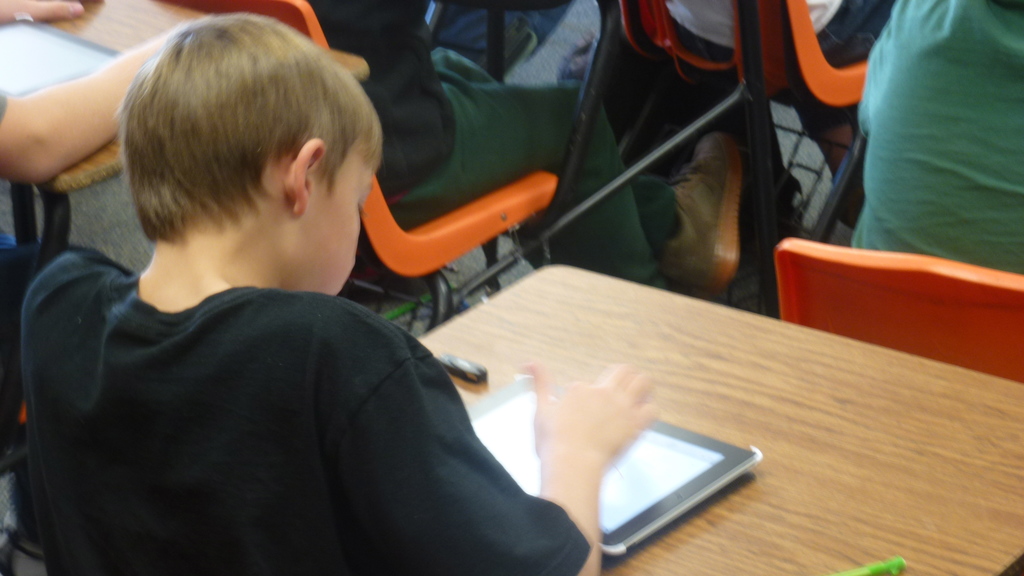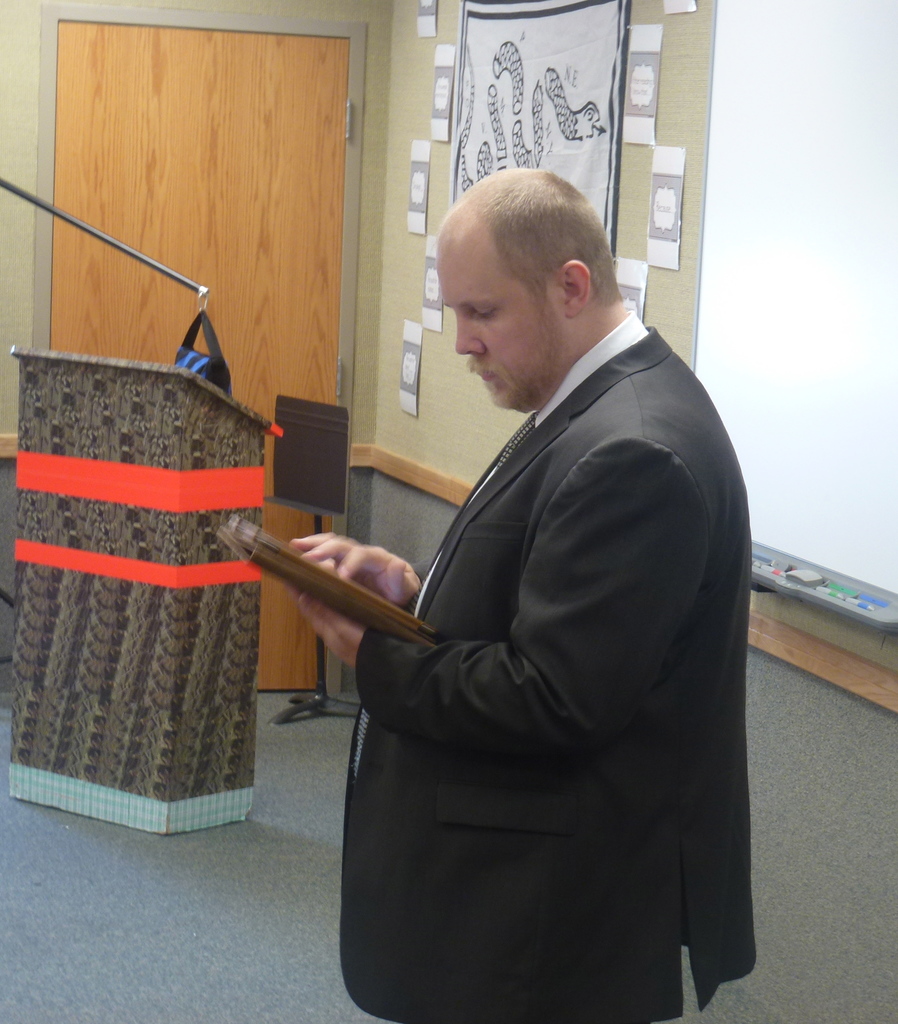EDITOR’S NOTE: Eleven Idaho schools are launching an experiment this fall. They are using $3 million in state grants to try out methods of using technology in the schools. This is the ninth of a series of stories on the grant recipients.
Is Facebook a good thing, or a bad thing?
Ask a middle school student, or a middle school student’s parent, and you’re likely to get a strong opinion. In the small Eastern Idaho town of Dayton, in Trevor Jensen’s eighth-grade English class at Beutler Middle School, those opinions left students split for two days.

Students debated the pros and cons and found and shared links to news articles to support their opinion. They participated in an online survey to compare teen Facebook usage in their community to the national data. At the end of the two days, students could switch camps if they wanted.
Fittingly, much of the debate unfolded in a wired classroom. A $138,718.74 state grant has provided iPads to Beutler’s 135 students — changing the way teachers teach and the way students absorb material.
Seeking a smooth transition
It’s been a big year at Beutler, not just because of the two-year iPad pilot. The middle schoolers moved out of the Harold B. Lee Elementary School building, and into a newer building that had been used for West Side School District offices and community events. Part of the challenge in Beutler is managing change — including the change that comes with new iPads. Beutler was a top-rated school in Idaho’s most recent five-star ratings.“We didn’t want to see the iPad be a distraction to learning in any way,” district Superintendent and Beutler Principal Spencer Barzee said.
The school also wanted to minimize the household upheaval.
While most households in the district are online — Jensen polled his 54 seventh-graders recently, and all but two said they had home Internet — some parents worry about monitoring iPad use. In response, the school hosted two parent meetings to discuss digital citizenship, safeguards, talking to kids about Internet use and iPad basics; all parents attended a session or a makeup session, Jensen said. The school also is installing Internet filters on all the iPads.
When that is done, probably in the next couple of weeks, each student will have an iPad they can take home. But parents can opt out from allowing kids to take their devices home.
Preparing for high school, and beyond
Despite its high rating, Beutler is looking to improve in several areas. Boys are more likely to score low on language usage, according to the school’s grant application, while girls are more likely to struggle in science. Economically disadvantaged students score substantially lower than their peers. “These students have limited access to technological resources in the home that could extend their learning beyond the classroom,” the school said in its application.
The overarching goal is preparing its middle schoolers for the rigors that await in high school — and beyond.
“All of our students are expected to take college and/or digital coursework while in high school,” Beutler says in its grant application. “(Beutler) must prepare students with higher order thinking skills and the ability to use technology as a tool for learning.”
A collaborative effort
Teachers and students are all expected to coach each other through the iPad rollout.
Jensen, who doubles as Beutler’s integration specialist for technology, runs weekly in-service sessions on Friday mornings. But he isn’t teaching alone. Teachers are encouraged to look for apps that work well in their classroom — and then teach their peers.
Then there’s the inevitable coaching teachers receive from computer-inclined students. “There’s nothing a middle school kid loves more than being the expert for a while,” said Cole Tarbet, Beutler’s IT manager.
Students are also expected to produce instructional videos — how-to videos on iPad use, and educational videos that, for example, might explain a literary term. Students are more likely to remember material when a classmate presents it, Jensen said, and the video format provides struggling students with a nontraditional venue where they can shine.
“It’s engaged those reluctant learners,” Jensen said.
A versatile tool
One recent afternoon, Shari Turnbow asked her sixth-graders to draw something that shows “impermeable.” A couple of students groaned. But the class went quickly to work. Within a minute, students were beginning to hold their iPads aloft, to show Turnbow their drawings.
One drew an impenetrable door.
A couple of minutes later, students were asked to draw something “perilous.” One student, perhaps in the spirit of Halloween, drew a zombie — which, said Turnbow, falls within the definition of perilous.
Whether it’s a vocabulary test — or a music class, where an app allows a teacher to watch recordings of student practices, and critique their posture and breathing technique — the iPads are changing learning at Beutler in many ways.

The iPads are even changing an old classroom staple, the test, and helping the school figure out a real-time use for a much-maligned data system.
Beutler is beginning to use the iPads for student tests, administered through the Schoolnet student data collection system that is being piloted statewide.
Through Schoolnet, Jensen can track student test performance on his iPad. The results, updated every five to 10 seconds, allow Jensen to spot trends immediately, and begin remediation immediately. Meanwhile, students like getting scores quickly, while the test is fresh in their minds.
Some school officials have complained that Schoolnet is unwieldy and fraught with errors — and in Beutler’s case, logging in for the first online tests proved cumbersome. But Jensen and Barzee see the potential.
“Without (the iPads), I think it really would be a struggle to implement Schoolnet at its capabilities,” Barzee said.
Disclosure: Schoolnet was funded with a startup grant from the J.A. and Kathryn Albertson Foundation, which also funds Idaho Education News.
More stories about the 11 Idaho schools using $3 million in state grants to try out methods of using technology in the schools:
- A schoolwide Chromebooks project at Kuna Middle School.
- A career-oriented laptop pilot at Middleton High School.
- An attempt to reverse achievement gaps at Parma Middle School.
- A writing emphasis at Weiser’s Park Intermediate School.
- A collaborative learning effort at Meridian’s Discovery Elementary School.
- A student-led iPad rollout at McCall-Donnelly High School.
- An effort to bridge geographic gaps at the Idaho Distance Education Academy.
- A Proposition 3 lookalike at Sugar Salem High School.
